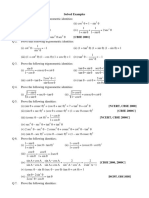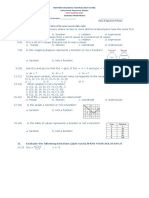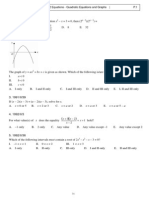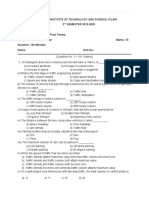0 ratings0% found this document useful (0 votes)
294 viewsQuadratic Functions 1
This document discusses identifying and graphing quadratic functions. It begins with examples of identifying quadratic functions from tables of values and equations by checking if the second differences are constant. It explains that the graph of a quadratic function is a parabola, and that the direction the parabola opens (upward or downward) depends on the sign of the leading coefficient a. The vertex is identified as the highest or lowest point of the parabola. Examples are provided of finding the minimum or maximum from the vertex, as well as determining the domain and range of quadratic functions from their graphs.
Uploaded by
api-312549818Copyright
© © All Rights Reserved
Available Formats
Download as PPT, PDF, TXT or read online on Scribd
0 ratings0% found this document useful (0 votes)
294 viewsQuadratic Functions 1
This document discusses identifying and graphing quadratic functions. It begins with examples of identifying quadratic functions from tables of values and equations by checking if the second differences are constant. It explains that the graph of a quadratic function is a parabola, and that the direction the parabola opens (upward or downward) depends on the sign of the leading coefficient a. The vertex is identified as the highest or lowest point of the parabola. Examples are provided of finding the minimum or maximum from the vertex, as well as determining the domain and range of quadratic functions from their graphs.
Uploaded by
api-312549818Copyright
© © All Rights Reserved
Available Formats
Download as PPT, PDF, TXT or read online on Scribd
You are on page 1/ 26
9-1 Identifying Quadratic Functions
Warm Up
1. Evaluate x2 + 5x for x = 4 and x = 3.
36; 6
2. Generate ordered pairs for the function
y = x2 + 2 with the given domain.
D: {2, 1, 0, 1, 2}
x
Holt McDougal Algebra 1
9-1 Identifying Quadratic Functions
Objectives
Identify quadratic functions and
determine whether they have a
minimum or maximum.
Graph a quadratic function and give its
domain and range.
Holt McDougal Algebra 1
9-1 Identifying Quadratic Functions
Vocabulary
quadratic function
parabola
vertex
minimum
maximum
Holt McDougal Algebra 1
9-1 Identifying Quadratic Functions
The function y = x2 is shown in the graph. Notice
that the graph is not linear. This function is a
quadratic function. A quadratic function is any
function that can be written in the standard form
y = ax2 + bx + c, where a, b, and c are real
numbers and a 0. The function y = x2 can be
written as y = 1x2 + 0x + 0, where a = 1,
b = 0, and c = 0.
Holt McDougal Algebra 1
9-1 Identifying Quadratic Functions
In Lesson 5-1, you identified linear functions by
finding that a constant change in x corresponded to a
constant change in y. The differences between yvalues for a constant change in x-values are called
first differences.
Holt McDougal Algebra 1
9-1 Identifying Quadratic Functions
Notice that the quadratic function y = x2 does not
have constant first differences. It has constant second
differences. This is true for all quadratic functions.
Holt McDougal Algebra 1
9-1 Identifying Quadratic Functions
Example 1A: Identifying Quadratic Functions
Tell whether the function is quadratic. Explain.
Since you are given a table
x
y
of ordered pairs with a
constant change in x2
9
+1
+7 6
values, see if the
1
2
second differences are
+1 +0
+1
constant.
0
1
+1
+1
+1
+7
+6
Find the first differences,
then find the second
differences.
The function is not quadratic. The second differences
are not constant.
Holt McDougal Algebra 1
9-1 Identifying Quadratic Functions
Caution!
Be sure there is a constant change in x-values
before you try to find first or second differences.
Holt McDougal Algebra 1
9-1 Identifying Quadratic Functions
Example 1B: Identifying Quadratic Functions
Tell whether the function is quadratic. Explain.
y = 7x + 3
Since you are given an equation,
use y = ax2 + bx + c.
This is not a quadratic function because the value
of a is 0.
Holt McDougal Algebra 1
9-1 Identifying Quadratic Functions
Example 1C: Identifying Quadratic Functions
Tell whether the function is quadratic. Explain.
y 10x2 = 9
y 10x = 9
+ 10x2 +10x2
y = 10x2 + 9
2
Try to write the function in the
form y = ax2 + bx + c by
solving for y. Add 10x2 to
both sides.
This is a quadratic function because it can be written
in the form y = ax2 + bx + c where a = 10, b = 0, and
c =9.
Holt McDougal Algebra 1
9-1 Identifying Quadratic Functions
Helpful Hint
In a quadratic function, only a cannot equal 0. It
is okay for the values of b and c to be 0.
Holt McDougal Algebra 1
9-1 Identifying Quadratic Functions
Check It Out! Example 1a
Tell whether the function is quadratic. Explain.
{(2, 4), (1, 1), (0, 0), (1, 1), (2, 4)}
List the ordered pairs in a
x
y
table of values. Since
there is a constant
2
4
+1
3
change in the x-values,
+2
1
1
see if the differences are
+1
1
+2
constant.
0
0
+1
+1
+1
+3
+2
Find the first differences,
then find the second
differences.
The function is quadratic. The second differences are
constant.
Holt McDougal Algebra 1
9-1 Identifying Quadratic Functions
Check It Out! Example 1b
Tell whether the function is quadratic. Explain.
y + x = 2x2
y + x = 2x2
x
x
y = 2x2 x
Try to write the function in the
form y = ax2 + bx + c by
solving for y. Subtract x from
both sides.
This is a quadratic function because it can be written
in the form y = ax2 + bx + c where a = 2, b = 1, and
c = 0.
Holt McDougal Algebra 1
9-1 Identifying Quadratic Functions
The graph of a quadratic function
is a curve called a parabola. To
graph a quadratic function,
generate enough ordered pairs to
see the shape of the parabola.
Then connect the points with a
smooth curve.
Holt McDougal Algebra 1
9-1 Identifying Quadratic Functions
Check It Out! Example 2a
Use a table of values to graph each quadratic
function.
y = x2 + 2
x
Holt McDougal Algebra 1
Make a table of values.
Choose values of x and
use them to find values
of y.
Graph the points. Then
connect the points with a
smooth curve.
9-1 Identifying Quadratic Functions
Check It Out! Example 2b
Use a table of values to graph the quadratic
function.
y = 3x2 + 1
x
11
11
Holt McDougal Algebra 1
Make a table of values.
Choose values of x and
use them to find values
of y.
Graph the points. Then
connect the points with a
smooth curve.
9-1 Identifying Quadratic Functions
As shown in the graphs in Examples 2A and 2B,
some parabolas open upward and some open
downward. Notice that the only difference
between the two equations is the value of a.
When a quadratic function is written in the form
y = ax2 + bx + c, the value of a determines the
direction a parabola opens.
A parabola opens upward when a > 0.
A parabola opens downward when a < 0.
Holt McDougal Algebra 1
9-1 Identifying Quadratic Functions
Example 3A: Identifying the Direction of a Parabola
Tell whether the graph of the quadratic
function opens upward or downward. Explain.
Write the function in the form
y = ax2 + bx + c by solving for y.
Add
to both sides.
Identify the value of a.
Since a > 0, the parabola opens upward.
Holt McDougal Algebra 1
9-1 Identifying Quadratic Functions
Example 3B: Identifying the Direction of a Parabola
Tell whether the graph of the quadratic
function opens upward or downward. Explain.
y = 5x 3x2
y = 3x2 + 5x
Write the function in the
form y = ax2 + bx + c.
a = 3
Identify the value of a.
Since a < 0, the parabola opens downward.
Holt McDougal Algebra 1
9-1 Identifying Quadratic Functions
The highest or lowest point on a parabola is the
vertex. If a parabola opens upward, the vertex is
the lowest point. If a parabola opens downward,
the vertex is the highest point.
Holt McDougal Algebra 1
9-1 Identifying Quadratic Functions
Holt McDougal Algebra 1
9-1 Identifying Quadratic Functions
Example 4: Identifying the Vertex and the Minimum
or Maximum
Identify the vertex of each parabola. Then give
the minimum or maximum value of the function.
A.
B.
The vertex is (3, 2), and
the minimum is 2.
Holt McDougal Algebra 1
The vertex is (2, 5), and
the maximum is 5.
9-1 Identifying Quadratic Functions
Check It Out! Example 4
Identify the vertex of each parabola. Then give
the minimum or maximum value of the function.
a.
b.
The vertex is (2, 5) and
the maximum is 5.
Holt McDougal Algebra 1
The vertex is (3, 1), and
the minimum is 1.
9-1 Identifying Quadratic Functions
Unless a specific domain is given, you may assume
that the domain of a quadratic function is all real
numbers. You can find the range of a quadratic
function by looking at its graph.
For the graph of y = x2 4x + 5,
the range begins at the minimum
value of the function, where y = 1.
All the y-values of the function are
greater than or equal to 1. So the
range is y 1.
Holt McDougal Algebra 1
9-1 Identifying Quadratic Functions
Example 5: Finding Domain and Range
Find the domain and range.
Step 1 The graph opens
downward, so identify the
maximum.
The vertex is (5, 3), so
the maximum is 3.
Step 2 Find the domain and
range.
D: all real numbers
R: y 3
Holt McDougal Algebra 1
9-1 Identifying Quadratic Functions
Check It Out! Example 5a
Find the domain and range.
Step 1 The graph opens
upward, so identify the
minimum.
The vertex is (2, 4), so
the minimum is 4.
Step 2 Find the domain and
range.
D: all real numbers
R: y 4
Holt McDougal Algebra 1
You might also like
- Xi - Maths - Chapter 11 - Hyperbolic Functions (156-165)No ratings yetXi - Maths - Chapter 11 - Hyperbolic Functions (156-165)10 pages
- ARCO SAT Subject Math Level 2 Practice TestNo ratings yetARCO SAT Subject Math Level 2 Practice Test23 pages
- CBSE Class 9 Mathematics Revision AssignmentsNo ratings yetCBSE Class 9 Mathematics Revision Assignments17 pages
- Solve Trig Equations Worksheet 12.15 Pp4yf1 PDFNo ratings yetSolve Trig Equations Worksheet 12.15 Pp4yf1 PDF3 pages
- Lesson 1.5 Algebra - Variables and ExpressionsNo ratings yetLesson 1.5 Algebra - Variables and Expressions4 pages
- Unit 2 Test: Identify The Choice That Best Completes The Statement or Answers The QuestionNo ratings yetUnit 2 Test: Identify The Choice That Best Completes The Statement or Answers The Question7 pages
- Exponential and Logarithmic Function (Q)No ratings yetExponential and Logarithmic Function (Q)29 pages
- Key Features of Polynomial Graphs: How To Find ThemNo ratings yetKey Features of Polynomial Graphs: How To Find Them3 pages
- M3T2 Worksheet 1 (Exponential Functions)No ratings yetM3T2 Worksheet 1 (Exponential Functions)6 pages
- 9-2 Practice: Transformations of Quadratic FunctionsNo ratings yet9-2 Practice: Transformations of Quadratic Functions1 page
- Hkcee Mathematics - 4.1 Polynomials - Function and Graph - P.1No ratings yetHkcee Mathematics - 4.1 Polynomials - Function and Graph - P.13 pages
- 08 - Trigonometric Functions, Identities and Equations100% (1)08 - Trigonometric Functions, Identities and Equations3 pages
- Transformations of Exponential & Logarithmic Functions100% (1)Transformations of Exponential & Logarithmic Functions3 pages
- Identifying Quadratic Functions Using Table of Values, Graphs and Equations - PPT-JDLCNo ratings yetIdentifying Quadratic Functions Using Table of Values, Graphs and Equations - PPT-JDLC22 pages
- Algorithms - Algorithm Fundamentals - AnswersNo ratings yetAlgorithms - Algorithm Fundamentals - Answers6 pages
- Matlab Program: 1 Response of First Order System To Unit Step InputNo ratings yetMatlab Program: 1 Response of First Order System To Unit Step Input6 pages
- Design and Analysis of Algorithms Solved MCQs (Set-11)No ratings yetDesign and Analysis of Algorithms Solved MCQs (Set-11)7 pages
- 2023-Analysis of Software Effort Estimation by Machine Learning TechniquesNo ratings yet2023-Analysis of Software Effort Estimation by Machine Learning Techniques14 pages
- Index: Practical Genetic Algorithms, Second Edition, by Randy L. Haupt and Sue Ellen HauptNo ratings yetIndex: Practical Genetic Algorithms, Second Edition, by Randy L. Haupt and Sue Ellen Haupt3 pages
- Chapter 4 Hamilton Variational Principle Hamilton Jacobi Eq Classical Mechanics 1100% (1)Chapter 4 Hamilton Variational Principle Hamilton Jacobi Eq Classical Mechanics 164 pages
- (Ebook PDF) Applied Biomedical Engineering Using Artificial Intelligence and Cognitive Models 1st edition by Jorge Garza Ulloa 0128209348 9780128209349 full chapters - The full ebook set is available with all chapters for download100% (6)(Ebook PDF) Applied Biomedical Engineering Using Artificial Intelligence and Cognitive Models 1st edition by Jorge Garza Ulloa 0128209348 9780128209349 full chapters - The full ebook set is available with all chapters for download76 pages
- Detection and Analysis of AD Using Various MachineNo ratings yetDetection and Analysis of AD Using Various Machine26 pages
- Deep Learning - From Big Data To Artificial Intelligence With - Stephane S - Tuffery - 2022 - Wiley - 9781119845010 - Anna's ArchiveNo ratings yetDeep Learning - From Big Data To Artificial Intelligence With - Stephane S - Tuffery - 2022 - Wiley - 9781119845010 - Anna's Archive542 pages
- Xi - Maths - Chapter 11 - Hyperbolic Functions (156-165)Xi - Maths - Chapter 11 - Hyperbolic Functions (156-165)
- Unit 2 Test: Identify The Choice That Best Completes The Statement or Answers The QuestionUnit 2 Test: Identify The Choice That Best Completes The Statement or Answers The Question
- Key Features of Polynomial Graphs: How To Find ThemKey Features of Polynomial Graphs: How To Find Them
- 9-2 Practice: Transformations of Quadratic Functions9-2 Practice: Transformations of Quadratic Functions
- Hkcee Mathematics - 4.1 Polynomials - Function and Graph - P.1Hkcee Mathematics - 4.1 Polynomials - Function and Graph - P.1
- 08 - Trigonometric Functions, Identities and Equations08 - Trigonometric Functions, Identities and Equations
- Transformations of Exponential & Logarithmic FunctionsTransformations of Exponential & Logarithmic Functions
- Identifying Quadratic Functions Using Table of Values, Graphs and Equations - PPT-JDLCIdentifying Quadratic Functions Using Table of Values, Graphs and Equations - PPT-JDLC
- Matlab Program: 1 Response of First Order System To Unit Step InputMatlab Program: 1 Response of First Order System To Unit Step Input
- Design and Analysis of Algorithms Solved MCQs (Set-11)Design and Analysis of Algorithms Solved MCQs (Set-11)
- 2023-Analysis of Software Effort Estimation by Machine Learning Techniques2023-Analysis of Software Effort Estimation by Machine Learning Techniques
- Index: Practical Genetic Algorithms, Second Edition, by Randy L. Haupt and Sue Ellen HauptIndex: Practical Genetic Algorithms, Second Edition, by Randy L. Haupt and Sue Ellen Haupt
- Chapter 4 Hamilton Variational Principle Hamilton Jacobi Eq Classical Mechanics 1Chapter 4 Hamilton Variational Principle Hamilton Jacobi Eq Classical Mechanics 1
- (Ebook PDF) Applied Biomedical Engineering Using Artificial Intelligence and Cognitive Models 1st edition by Jorge Garza Ulloa 0128209348 9780128209349 full chapters - The full ebook set is available with all chapters for download(Ebook PDF) Applied Biomedical Engineering Using Artificial Intelligence and Cognitive Models 1st edition by Jorge Garza Ulloa 0128209348 9780128209349 full chapters - The full ebook set is available with all chapters for download
- Detection and Analysis of AD Using Various MachineDetection and Analysis of AD Using Various Machine
- Deep Learning - From Big Data To Artificial Intelligence With - Stephane S - Tuffery - 2022 - Wiley - 9781119845010 - Anna's ArchiveDeep Learning - From Big Data To Artificial Intelligence With - Stephane S - Tuffery - 2022 - Wiley - 9781119845010 - Anna's Archive

























































































